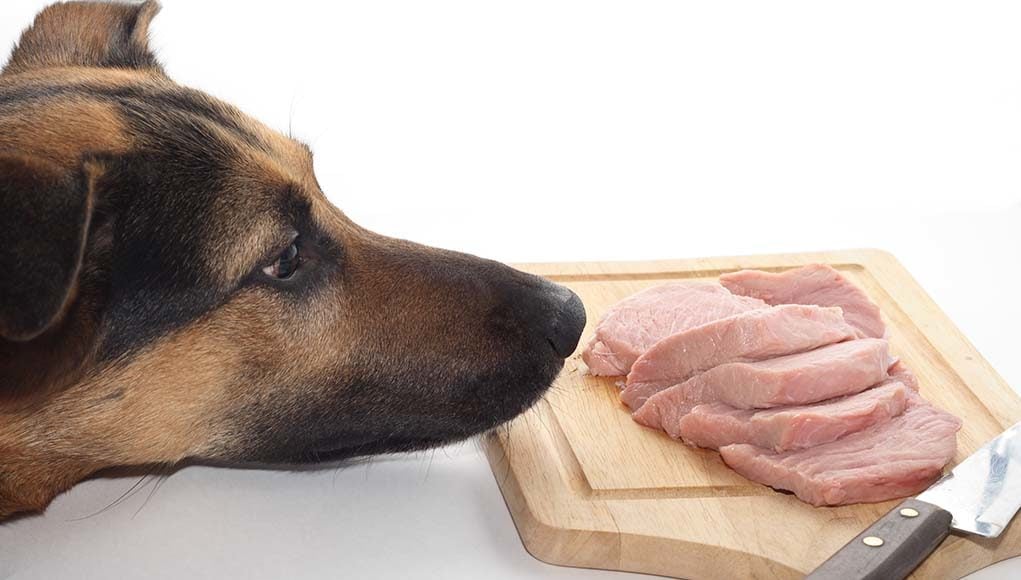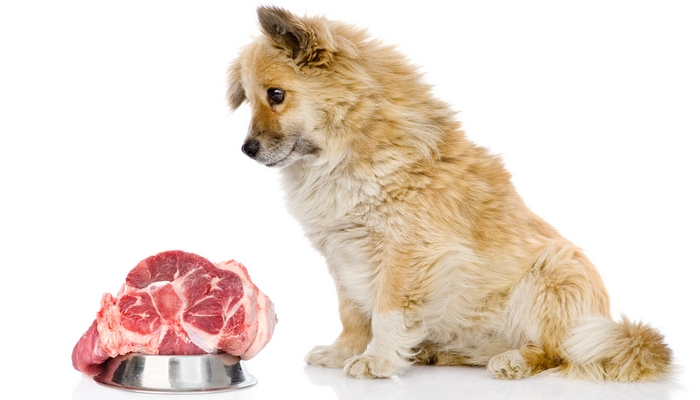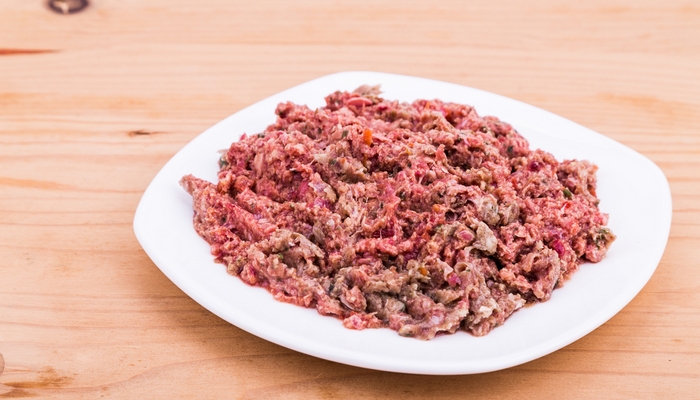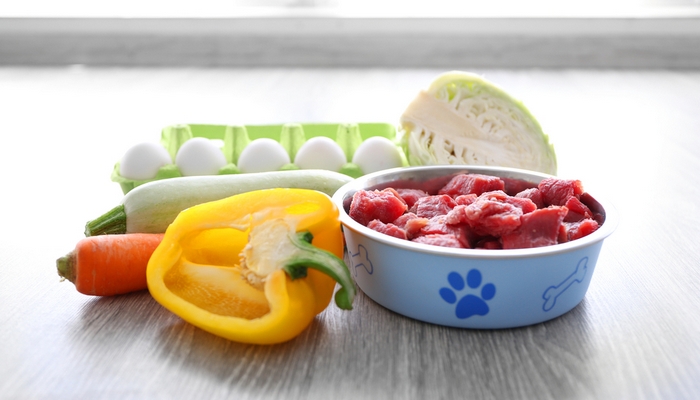The raw food diet for dogs has gained a lot of attention in the last few years. As pet owners seek healthier diets for themselves, they're also looking for healthier food for dogs. But is the raw dog food diet actually a healthier option than commercial dog food brands, and is raw dog food even safe?
Before you can begin looking into the safety of the raw foods, you need to understand what a raw dog food diet actually is. According to raw food enthusiasts, a raw food diet means eating foods that are, for the most part, uncooked.
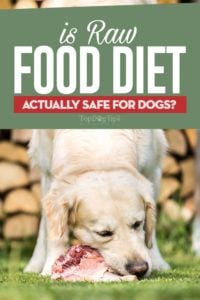 Foods in the raw food diet can include:
Foods in the raw food diet can include:
- Meat
- Eggs
- Seeds
- Nuts
- Grains
- Fresh vegetables
- Fresh fruits
- Beans
- Dried fruits
There are known health benefits to eating a diet consisting of raw foods, but mostly it depends on the choice of foods included in the diet rather than the cooking process.
For example, if your diet is over 70% fresh fruits and vegetables (little meat), you may have a decreased risk of heart disease because of improved LDL cholesterol levels. But you may be at increased risk of coronary artery disease due to lack of Vitamin B12.
However, cooking processes do matter as well, and raw food diets have some benefits to claim. Studies published in medical literature state that some natural enzymes found in uncooked foods work with your own digestive tract to increase the nutritional value of food once ingested. When heated, these foods are altered and work less efficiently.
While a raw food diet can help you lose weight and may be able to enhance your body’s ability to fight disease, increase absorption of nutrients and otherwise improve health, does this type of raw diet offer the same benefits for pets? Let's find out.
RELATED: Raw Diet for Dogs 101 – The Ultimate Guide
Is a Raw Food Diet Safe for Dogs?
Exploring Myths and Facts
Benefits of a raw dog food diet
While no studies have been done to demonstrate the long-term effects of a raw food diet in pets, there are many theories and opinions of the benefits. Some of the advantages owners, trainers and breeders report are more energy, better skin and coat condition and improved overall health.
Pet owners surveyed in the US and Austrailia have claimed that their pets were healthy after consuming raw food diets. The owners rated the health of their pets by answering a series of multiple-choice questions.
The pets in this study, however, did not eat an exclusive diet of raw foods. In fact, only about 16% of the main meal was raw for dogs, and only 9% was raw for the cats.
MORE ON BENEFITS: 8 Reasons To Feed Your Dog A Raw Food Diet
Risks of a raw dog food diet
Unfortunately, there is more hard evidence available for the risks to pets who eat raw food than for the benefits.
- some puppies fed a diet of only rice and raw meat developed a disorder that can result in the weakening of bones;
- other puppies fed a diet of bones and raw food (referred to as BARF), developed a painful bone disease;
- one cat fed a pork liver diet had a severe vitamin imbalance that was reversed once the cat was fed a commercial cat food in place of the raw diet;
- ten cats fed cooked pig brains or raw oily fish developed a rare, painful skin disorder.
A common thread in many of the issues reported appears to be vitamin and mineral deficiency. Your body can’t make all of the necessary vitamins and minerals to meet your nutritional needs. Eating a variety of foods ensures you take in the vitamins and minerals you need.
MORE ON RISKS: 7 Reasons NOT To Feed Your Dog Raw Dog Food
Can humans get sick if their pets eat a raw diet?
In short, yes. Infectious agents found in raw food can contaminate the pet’s environment and cause illness in humans. If the dog eats contaminated food, they are likely to expel the bacteria in their stool, people who may come into contact with the feces may become infected with that bacteria.
Commercially prepared raw meat dog foods (containing beef, chicken, turkey, or lamb) have tested positive for E. coli, Salmonella, and other forms of bacteria. Salmonella has a variety of strains, or types. For the purposes of this article, the word Salmonella is used without specifying the particular type.
In one study, 20 different commercially available raw meat diets for dogs were tested. The conclusion reached was that contamination from bacteria is common in commercially prepared raw meat diets.
This contamination only increases the risk of food borne illness in dogs and even the people who work around (or live with) the dogs.
Raw food available from pet stores in three Canadian cities were found to contain eighteen types of Salmonella – some even had resistance to antibiotics. Resistance to antibiotics makes the chance of infection greater since bacterial growth is not slowed, or stopped, by some antibiotics.
A similar study compared homemade raw chicken and vegetable diets to commercial dry food. The people who feed this type of diet claim it improves the dogs coat and skin, overall health and even decreases body odor. At the start of the study, all the dogs tested negative for Salmonella.
At the end of the study, the dogs fed the commercial dry food were still negative for Salmonella while 80% of the dogs fed the homemade raw food had Salmonella in their stool. It was concluded that owners should think carefully about the risks to children and those who have compromised immune systems when feeding dogs a raw meat diet.
SIMILAR: Pros and Cons of the BARF Diet for Dogs
Frozen commercial raw food has tested positive for Salmonella too. Dogs fed this diet (all of whom tested negative for Salmonella before eating the food) had Salmonella in their stool after consuming the product.
In 1999 and 2000, there were 4 outbreaks of stomach illness caused by one type of Salmonella in 4 animal facilities. The employees, clients and animals were from 3 area veterinary clinics and 1 animal shelter. These outbreaks clearly show that animal care facilities are also potential sources of transmission if precautions are not taken.
Other studies have found:
- evidence that natural pet treats can be contaminated with Salmonella;
- in Canada, in 1999, pig ear treats caused an outbreak of Salmonella in both dogs and humans;
- two cats who lived in the same house were fed a homemade, raw meat diet and contracted a strain of salmonella and died.
Precautions to take when serving a raw dog food diet
If you decide that raw food is the best thing for your pet – care must be taken when preparing the food and cleaning up after your dog. However, traditional cleaning methods may not be effective.
Some strains of Salmonella can survive a trip through the dishwasher. Bleach has even proven ineffective against some strains of Salmonella. To ensure that you kill any traces of the bacteria:
- Remove any uneaten food from bowl
- Disinfect food bowl (soak in a 10% bleach/90% hot water mixture)
- Scrub food bowl thoroughly


